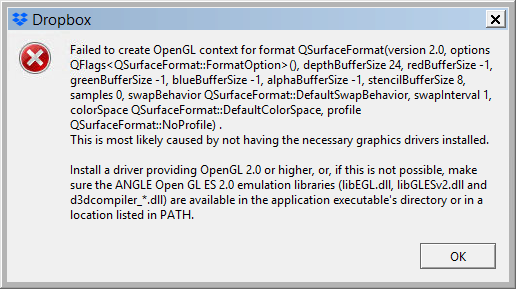
- #Install a driver providing opengl 2.0 or higher install
- #Install a driver providing opengl 2.0 or higher drivers
- #Install a driver providing opengl 2.0 or higher windows 10
- #Install a driver providing opengl 2.0 or higher download
#Install a driver providing opengl 2.0 or higher install
Install a driver providing OpenGL 2.0 or higher, or, if this is not possible, make sure the ANGLE Open GL ES 2.0 emulation libraries (libEGL.dll, libGLESv2.dll and d3dcompiler_*.dll) are available in the application executable's directory or in a location listed in PATH.
#Install a driver providing opengl 2.0 or higher drivers
This is most likely caused by not having the necessary graphics drivers installed. Perhaps, Musecore 3 should include and default to these emulation files if Open2.0 is not available?)įailed to create OpenGL context for format QSurfaceFormat(version 2.0, options QFlags(), depthBufferSize 24, redBufferSize -1, greenBufferSize -1, blueBufferSize -1, alphaBufferSize -1, stencilBufferSize 8, samples 0, swapBehavior QSurfaceFormat::SwapBehavior(DefaultSwapBehavior), swapInterval 1, profile QSurfaceFormat::OpenGLContextProfile(NoProfile)). If it's because my graphics card is too dated to run Open GL 2.0, where do I get the ANGLE Open GL ES 2.0 emulation libraries (libEGL.dll, libGLESv2.dll and d3dcompiler_*.dll) to put in the Musescore directory? (Hopefully, Musecore 3 will be able to run on older 64bit computers once it is officially released.
#Install a driver providing opengl 2.0 or higher windows 10
Otherwise, I’m not sure what else to try.I get the below error when running Musescore Alpha 3 from its directory on my Latitude E6410, running Windows 10 64bit. If something goes wrong and Anki won’t open after enabling hardware acceleration, use this help. Open Anki, enable hardware acceleration in the Tools - Preferences and restart Anki. It seems like there’re two versions available that support NVIDIA GeForce 1060, but as far as I understand it’s just a matter of choice since they both have libEGL.dll, libGLEv2.dll and d3dcompiler_*.dll included that seems to be required by Anki and hardware acceleration.
#Install a driver providing opengl 2.0 or higher download
I don’t know how you updated it in the first post since you got the error messageįailed to create OpenGL context … Install a driver providing OpenGL2.0 or higherīut try to download and install it from if you didn’t do it already. Since you’re on Anki 2.1.29, I think, it’d be better to download and install the latest Anki 2.1.31 beta version - Anki 2.1.31 BetaĪbout the window freezing while using keyboard shortcuts to change input language, I’m not sure about it and it might not help, but maybe try to enable hardware acceleration in Anki. Then Windows prompted me to restart to update, I did that and was able in install the newest version, but now when I try to run Anki, the same profile window comes up and a prompt to download the latest version of Anki (which, I now have installed), and clicking on “Open” just causes Anki to flash and then not do anything. It opened a window where downgrade and quit was an option, but when I tried that, it said my profile couldn’t be downgraded. I was able to install it, but when I tried to run Anki, it asked if I had forgotten to downgrade my profile because the current one needed a newer version. So then I downloaded the last stable 2.1.26.

But when trying to install, the installation failed with the error: “Error opening file for writing: C:\Program Files\Anki\mvp.exe Click retry or try again or Cancel to stop the installation.” Retrying wouldn’t work. intel hd 3000 official drivers do not really support openGL of version greater than 3. So then I downloaded and tried to install the latest version 2.1.30-windows. Download and install OpenGL Extensions Viewer (free of charge). I did this and it opened, but when I tried to study a deck, Anki froze and stopped responding. Installing the OpenGL 2.0 Emulator on Microsoft Windows Select the package to download: OpenGLES20EmulatorWinXPv m. Install a driver providing OpenGL2.0 or higher, or if this is not possible, make sure the ANGLE Open GL ES 2.0 emulation libraries (libEGL.dll, libGLEv2.dll and d3dcompiler_*.dll) are available in the application executable’s directory or in a location listed in PATH."īut then it also suggested I close Anki and restart to use a different driver. "Failed to create OpenGL context for format QSurfaceFormat(version 2.0, options Qflags QSurfaceFormat::FormatOption(), depthBufferSize 24, redBufferSize -1, greenBufferSize -1, blueBufferSize -1, alphaBufferSize -1, stecilBufferSize 8, samples 0, swapBehavior QSurfaceFormat::DefaultSwapBehavior, swapInterval 1, colorSpace QSurfaceFormat::DefaultColorSpace, profile QSurfaceFormat::NoProfile). I also updated the driver for the NVIDIA card.Īfter that, I tried to run Anki and got this error message: When I installed it, a new display adapter showed up which seems to be associated with the new monitor. My two other monitors are connected to my computer on a DP port, this new one is using and HDMI port. I have a 3-monitor setup and an NVIDIA GeForce 1060 graphics card.

I installed a new monitor on my computer yesterday. Hi, I’m not very technically inclined, but I’ve been using Anki without issue for years until yesterday.


 0 kommentar(er)
0 kommentar(er)
